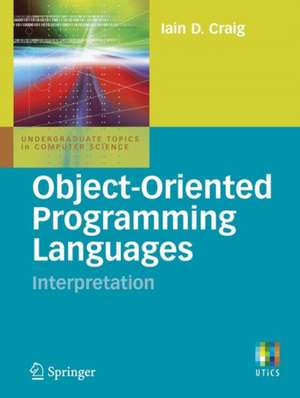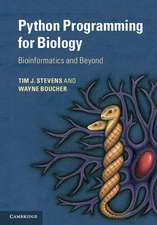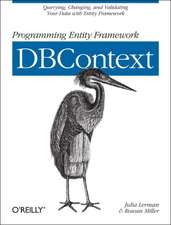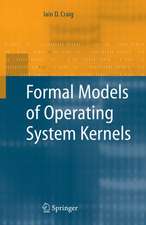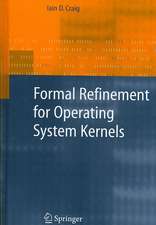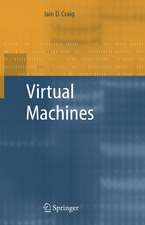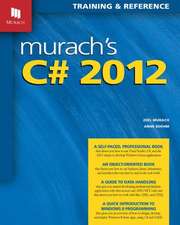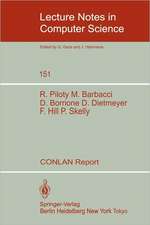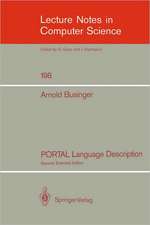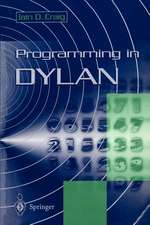Object-Oriented Programming Languages: Interpretation: Undergraduate Topics in Computer Science
Autor Iain D. Craigen Limba Engleză Paperback – 26 apr 2007
Din seria Undergraduate Topics in Computer Science
- 20%
 Preț: 287.02 lei
Preț: 287.02 lei - 20%
 Preț: 316.24 lei
Preț: 316.24 lei - 20%
 Preț: 350.89 lei
Preț: 350.89 lei - 20%
 Preț: 227.15 lei
Preț: 227.15 lei - 20%
 Preț: 187.22 lei
Preț: 187.22 lei - 20%
 Preț: 280.92 lei
Preț: 280.92 lei - 20%
 Preț: 306.71 lei
Preț: 306.71 lei - 20%
 Preț: 318.97 lei
Preț: 318.97 lei - 20%
 Preț: 258.78 lei
Preț: 258.78 lei - 20%
 Preț: 226.64 lei
Preț: 226.64 lei - 20%
 Preț: 179.87 lei
Preț: 179.87 lei - 20%
 Preț: 395.04 lei
Preț: 395.04 lei - 20%
 Preț: 225.02 lei
Preț: 225.02 lei - 20%
 Preț: 272.43 lei
Preț: 272.43 lei - 20%
 Preț: 306.58 lei
Preț: 306.58 lei - 20%
 Preț: 287.22 lei
Preț: 287.22 lei - 20%
 Preț: 305.01 lei
Preț: 305.01 lei - 20%
 Preț: 384.11 lei
Preț: 384.11 lei -
 Preț: 334.88 lei
Preț: 334.88 lei - 20%
 Preț: 305.61 lei
Preț: 305.61 lei - 20%
 Preț: 375.53 lei
Preț: 375.53 lei - 20%
 Preț: 276.82 lei
Preț: 276.82 lei - 20%
 Preț: 342.45 lei
Preț: 342.45 lei - 20%
 Preț: 254.37 lei
Preț: 254.37 lei - 20%
 Preț: 237.35 lei
Preț: 237.35 lei - 20%
 Preț: 316.07 lei
Preț: 316.07 lei - 20%
 Preț: 374.37 lei
Preț: 374.37 lei - 20%
 Preț: 245.43 lei
Preț: 245.43 lei - 20%
 Preț: 233.75 lei
Preț: 233.75 lei - 20%
 Preț: 307.16 lei
Preț: 307.16 lei - 20%
 Preț: 374.20 lei
Preț: 374.20 lei - 20%
 Preț: 246.39 lei
Preț: 246.39 lei - 20%
 Preț: 237.62 lei
Preț: 237.62 lei - 20%
 Preț: 463.43 lei
Preț: 463.43 lei - 20%
 Preț: 297.28 lei
Preț: 297.28 lei - 20%
 Preț: 304.44 lei
Preț: 304.44 lei - 20%
 Preț: 579.37 lei
Preț: 579.37 lei - 20%
 Preț: 298.18 lei
Preț: 298.18 lei - 20%
 Preț: 302.80 lei
Preț: 302.80 lei - 20%
 Preț: 300.89 lei
Preț: 300.89 lei - 20%
 Preț: 191.35 lei
Preț: 191.35 lei - 20%
 Preț: 243.35 lei
Preț: 243.35 lei - 20%
 Preț: 297.66 lei
Preț: 297.66 lei - 20%
 Preț: 278.10 lei
Preț: 278.10 lei - 20%
 Preț: 389.96 lei
Preț: 389.96 lei - 20%
 Preț: 184.28 lei
Preț: 184.28 lei - 20%
 Preț: 304.21 lei
Preț: 304.21 lei
Preț: 231.91 lei
Preț vechi: 289.89 lei
-20% Nou
Puncte Express: 348
Preț estimativ în valută:
44.39€ • 46.16$ • 37.20£
44.39€ • 46.16$ • 37.20£
Carte tipărită la comandă
Livrare economică 13-27 martie
Preluare comenzi: 021 569.72.76
Specificații
ISBN-13: 9781846287732
ISBN-10: 1846287731
Pagini: 264
Ilustrații: VIII, 256 p.
Dimensiuni: 178 x 235 x 19 mm
Greutate: 0.43 kg
Ediția:2007
Editura: SPRINGER LONDON
Colecția Springer
Seria Undergraduate Topics in Computer Science
Locul publicării:London, United Kingdom
ISBN-10: 1846287731
Pagini: 264
Ilustrații: VIII, 256 p.
Dimensiuni: 178 x 235 x 19 mm
Greutate: 0.43 kg
Ediția:2007
Editura: SPRINGER LONDON
Colecția Springer
Seria Undergraduate Topics in Computer Science
Locul publicării:London, United Kingdom
Public țintă
Lower undergraduateCuprins
Class Fundamentals.- Prototype and Actor Languages.- Inheritance and Delegation.- Methods.- Types I: Types and Objects.- Types II: Types and Objects–Alternatives.- C#.- BeCecil.
Recenzii
From the reviews:
"There are a lot of books concerning object-oriented programming or object-oriented languages, but only a very small number of them compare object-oriented languages or treat their characteristics in common. The author’s textbook belongs to them. The book focuses on the concepts of inheritance, encapsulation, polymorphism and their interactions in object-oriented languages. … The book can be used for second or third year undergraduate courses." (G. Riedewald, Zentralblatt MATH, Vol. 1128 (6), 2008)
"There are a lot of books concerning object-oriented programming or object-oriented languages, but only a very small number of them compare object-oriented languages or treat their characteristics in common. The author’s textbook belongs to them. The book focuses on the concepts of inheritance, encapsulation, polymorphism and their interactions in object-oriented languages. … The book can be used for second or third year undergraduate courses." (G. Riedewald, Zentralblatt MATH, Vol. 1128 (6), 2008)
Textul de pe ultima copertă
This comprehensive examination of the main approaches to object-oriented language explains the key features of the languages in use today. Class-based, prototypes and Actor languages are all looked at and compared in terms of their semantic concepts. In providing such a wide-ranging comparison, this book provides a unique overview of the main approaches to object-oriented languages.
Exercises of varying length, some of which can be extended into mini-projects are included at the end of each chapter. This book can be used as part of courses on Comparative Programming Languages or Programming Language Semantics at Second or Third Year Undergraduate Level. Some understanding of programming language concepts is required.
Exercises of varying length, some of which can be extended into mini-projects are included at the end of each chapter. This book can be used as part of courses on Comparative Programming Languages or Programming Language Semantics at Second or Third Year Undergraduate Level. Some understanding of programming language concepts is required.
Caracteristici
No other book on object-oriented programming has the range in terms of languages and concepts covered Includes a full set of exercises at the end of each chapter Request lecturer material: sn.pub/lecturer-material
